Excerpts from Jim Conrad's
Naturalist Newsletter
from the February 2, 2014 Newsletter issued from the Frio Canyon Nature Education Center in the valley of the Dry Frio River in northern Uvalde County, southwestern Texas, on the southern border of the Edwards Plateau; elevation ~1750m (~5750 ft); N29.62°, W99.86°; USA
DRAGONFLY NAIADS
In a shallow pool of the little Dry Frio River, when some blackened sycamore leaves sunken to the pool's bottom were stirred, a creature about ¾inch long (2cm) shot from among the leaves, settled at the pool's edge, grabbing onto a sycamore leaf's petiole. Below, you can see the bug-eyed little fellow submerged in about half a finger of water:
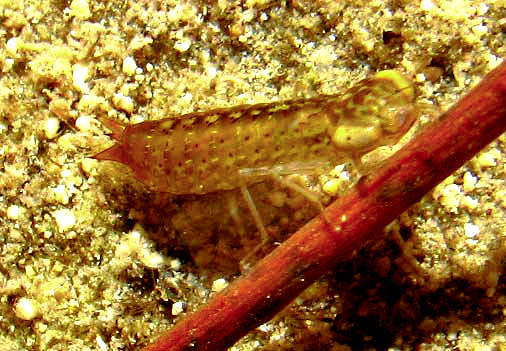
After taking that picture our discovery was coaxed into the palm of my hand, resulting in the picture below:
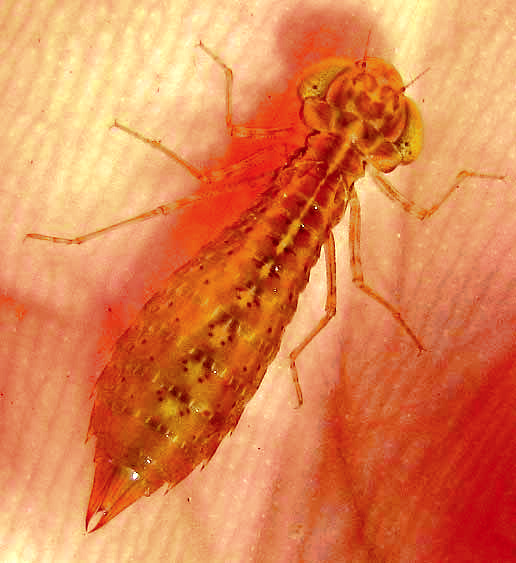
With six legs and no wings you might guess that this is an insect larva, and among the insects with big heads, large, widely spaced compound eyes and short, stiff antennae, and who hang around streams, what could this be but the larval stage of a dragonfly or damselfly? And since dragonflies and damselflies undergo incomplete metamorphosis where the larva emerging from the egg resembles a much smaller, wingless edition of the adult, the creature in the photo is a nymph. Moreover, nymphs of dragonflies and damselflies are known by the special name of naiad -- the word "naiad" rhyming with "pie ad." This particular naiad was obliging enough to allow the face portrait shown below:
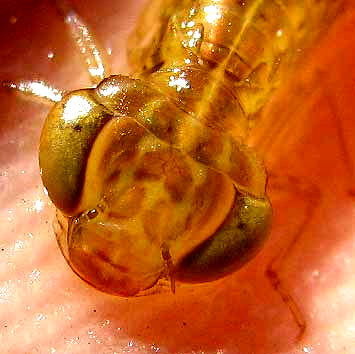
In that picture, behind the head, you can see two tiny flaps, which are incipient wings, or wing pads.
The leaf-stirring exercise was so successful that I stirred some more leaves, and out shot several more aquatic-larva-type creatures, but only about half the size of our naiad, and very differently colored.Below, you can see one:

A shot from a different angle is shown below:
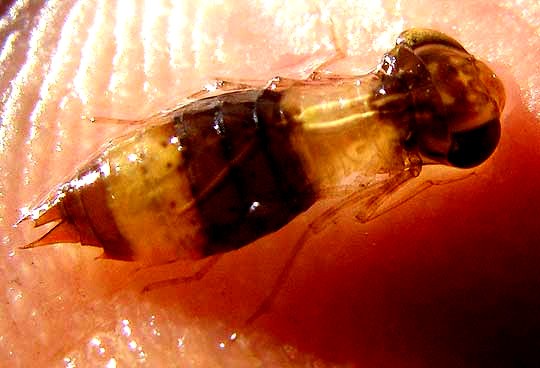
Were these two different species? Noticing that they shared similar patterning on their heads, I wondered whether the smaller one might be just a younger "instar." Remember that during incomplete metamorphosis, nymphal stages pass through a series of ever-larger, exoskeleton-shedding instars.
Volunteer identifier Bea in Ontario also suspected that the two naiad types were the same species. Moreover, she noticed that both early and late stages match other photos of naiads of the Common Green Darner, Anax junius, which occurs here, so that's our best bet for who we have here, but we can't be sure.
Whichever species they are, dragonfly naiads are known as voracious feeders who eat aquatic insects, especially mosquito larvae. Some large naiads even prey on small fish and tadpoles. They breathe through gills in their rectum, and when they need to move fast, as when they shoot from their cover of sunken sycamore leaves, they resort to jet propulsion by suddenly expelling water through their anuses.
from the February 2, 2014 Newsletter issued from the Frio Canyon Nature Education Center in the valley of the Dry Frio River in northern Uvalde County, southwestern Texas, on the southern border of the Edwards Plateau; elevation ~1750m (~5750 ft); N29.62°, W99.86°; USA
NAIAD MOUTHPARTS
Last month we couldn't identify those naiads because I hadn't known to notice the mouthparts, which is necessary. This week another dragonfly naiad turned up in a submerged green mat of filamentous algae and cyanobacteria cloaking a rock. This naiad was identical in structure to the previous ones, but black, as shown below:
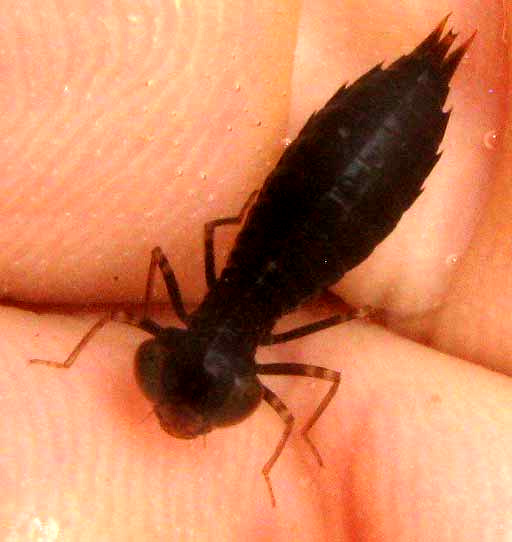
This time I coaxed the little critter onto his back so that the machinery of his mouthparts became visible, which you can see below:
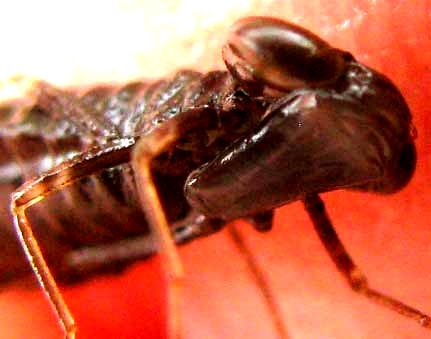
The shoe-shaped structure beneath the head and neck are the mouthparts, known as the labium. At the labium's rounded front you can barely see a kind of rim. The rim is composed of two merging pincers or jaws now closed against the labium. When the naiad grabs prey, the whole labium shoots forward like an arm with a hinged elbow, the pincers open and sink into the prey, the arm retracts to below the head to where the mouth is located, and then the naiad chews its prey.
Seeing what the mouthparts look like and using the well illustrated "Dragonfly Larvae Identification Key" it can be determined that our naiad belongs to the Darner Family, the Aeshnidae.
Michael Overton's "Odonates of Uvalde County, Texas Field Checklist" for our county lists five Darner Family species, so all I can say is that our naiad is some kind of darner dragonfly, of which the most widely spread and best known is the Common Green Darner.
from the June 23, 2008 Newsletter, issued from the forest near Natchez, Mississippi; elevation ~400ft (120m), ~N31.47°, ~W91.29°:
MUDDY NYMPH ON A LEAF
On vegetation arising from mud along Pipes Lake {~N31.38°, ~W91.16°, elev. ~140ft (~40m)} I found several bizarre-looking items, one being shown below:
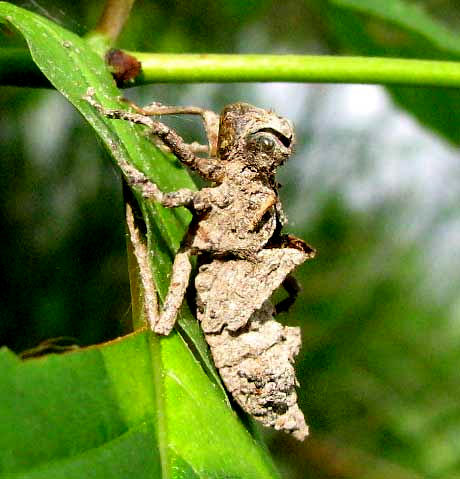
That's a dragonfly nymph's discarded exoskeleton, or "exuvia." Dragonfly metamorphosis is simple, so the dragonfly's immature stage is somewhat anatomically similar to the adult dragonfly, only that it's smaller, wingless, and aquatic. Immature stages of insects with simple metamorphosis are referred to as nymphs.
Dragonfly nymphs breathe underwater with gills in their rectums. Moreover, a nymph can move about using jet propulsion. It draws water into its rectum through the anus, then expels it, the faster the water being expelled, the faster the nymph shoots forward.
When a dragonfly nymph is ready to metamorphose into a flying adult, it pulls itself from the water, climbs what usually turns out to be shoreline vegetation, holds on tight as its exterior skeleton, or exoskeleton, begins splitting, and finally the interior being emerges from its old "skin," the exuvia.
The nymph exuvia in the picture is encrusted with mud. Still, you can see the gaping hole in its back where the new winged dragonfly emerged. I've watched this process before and can tell you that the newly minted dragonfly is very vulnerable to predation at this moment. Its new exoskeleton is still soft, and at first its wings aren't completely unfurled. For awhile you have a soft, juicy dragonfly who can't fly away, often in plain view of predators such as bullfrogs.
Damselflies also produce aquatic nymphs, but they are more slender than dragonfly nymphs. In fact, horsefly and deerfly nymphs are aquatic, too, but they are legless, looking somewhat like slender, conspicuously segmented torpedoes tapering at both ends.